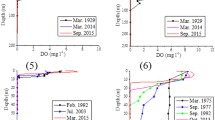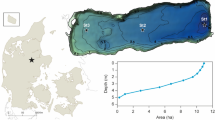Abstract
The concentration of dissolved oxygen in waters 0.5–0.6 m above the bottom of Lake Hibara, a dimictic lake, was zero in early spring of 1994 and 1997. The concentrations in early spring of 1992, 1993, 1995, 1996, and 1998 ranged from 3.75 to 10.1 mg l−1. The depth profiles of water temperature suggest that water had not circulated prior to the sample collections of 1994 and 1997, but it had done so in the cases of the other years, suggesting that winter conditions were well preserved in the former years. On the other hand, the dissolved oxygen in the same strata decreased severely in summer. However, more or less titratable amounts of dissolved oxygen still remained (0.01–0.73 mg l−1) at the final stages of summer stratification from 1992 to 1998. These facts show that a completely anoxic condition is not formed in this lake in summer but is sometimes formed in winter. It is interesting to note that in spite of unfavorable winter conditions for oxygen consumption, i.e., shorter duration and lower water temperature, oxygen is exhausted. These facts suggest that ventilation to the depths is much greater in summer than in winter.
Similar content being viewed by others
Author information
Authors and Affiliations
Additional information
Received: March 5, 1999 / Accepted: October 18, 1999
Rights and permissions
About this article
Cite this article
Satoh, Y., Kumagai, M., Sugawara, K. et al. Winter anoxic layer in Lake Hibara. Limnology 1, 69–72 (2000). https://doi.org/10.1007/s102010070031
Issue Date:
DOI: https://doi.org/10.1007/s102010070031




